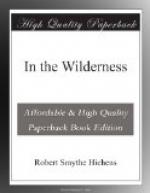Some of our best sportsmen, who desire to protract the pleasure of slaying deer through as many seasons as possible, object to the practice of the hunters, who make it their chief business to slaughter as many deer in a camping season as they can. Their own rule, they say, is to kill a deer only when they need venison to eat. Their excuse is specious. What right have these sophists to put themselves into a desert place, out of the reach of provisions, and then ground a right to slay deer on their own improvidence? If it is necessary for these people to have anything to eat, which I doubt, it is not necessary that they should have the luxury of venison.
One of the most picturesque methods of hunting the poor deer is called “floating.” The person, with murder in his heart, chooses a cloudy night, seats himself, rifle in hand, in a canoe, which is noiselessly paddled by the guide, and explores the shore of the lake or the dark inlet. In the bow of the boat is a light in a “jack,” the rays of which are shielded from the boat and its occupants. A deer comes down to feed upon the lily-pads. The boat approaches him. He looks up, and stands a moment, terrified or fascinated by the bright flames. In that moment the sportsman is supposed to shoot the deer. As an historical fact, his hand usually shakes so that he misses the animal, or only wounds him; and the stag limps away to die after days of suffering. Usually, however, the hunters remain out all night, get stiff from cold and the cramped position in the boat, and, when they return in the morning to camp, cloud their future existence by the assertion that they “heard a big buck” moving along the shore, but the people in camp made so much noise that he was frightened off.
By all odds, the favorite and prevalent mode is hunting with dogs. The dogs do the hunting, the men the killing. The hounds are sent into the forest to rouse the deer, and drive him from his cover. They climb the mountains, strike the trails, and go baying and yelping on the track of the poor beast. The deer have their established runways, as I said; and, when they are disturbed in their retreat, they are certain to attempt to escape by following one which invariably leads to some lake or stream. All that the hunter has to do is to seat himself by one of




